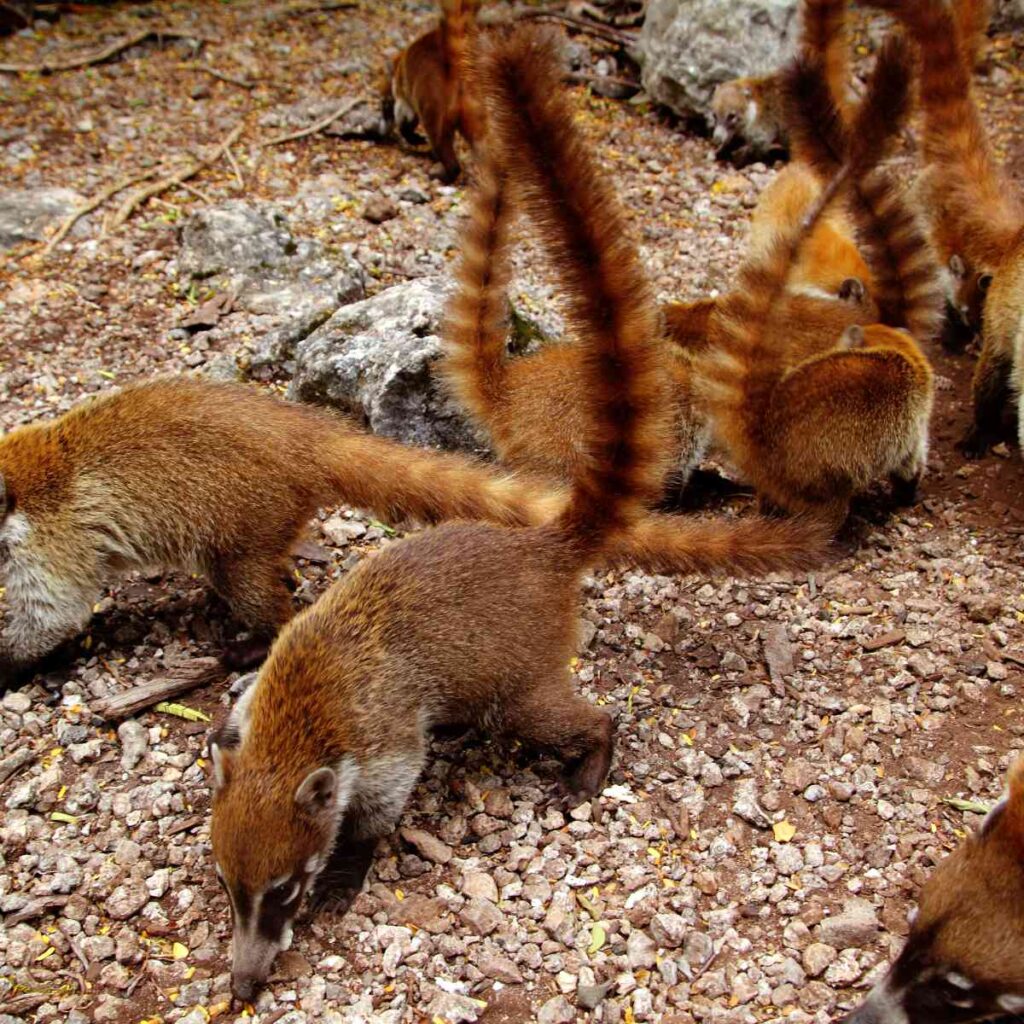Last Reviewed and Updated on February 7, 2023
Pig-like nose, raccoon-like tail, paws like that of a bear, and the looks of an anteater. Meet the coati! You have probably seen a viral video of these animals at some point where they look like tiny dinosaurs. Now it’s time to learn more about them, from the basics to some of the coolest facts about coati.

About Coati
Coatis are members of the family Procyonidae (along with raccoons, ringtails, cacomistles, kinkajous, olingos, and olinguitos). They are native to Central and South America, Mexico, and the southwestern United States. Coatis are widespread and can be found in areas ranging from hot and arid to humid rainforests and even cold Andean mountains.
There are four recognized living species of coatis;
- White-nosed coati
- South American coati
- Eastern moutain coati
- Western mountain coati
They have long bodies with relatively short legs, bushy tails, and distinctive snouts for foraging.
Coatis are omnivores and feed on a variety of food items such as insects, fruits, lizards, birds, small mammals, and bird eggs.
Coatis reproduce once a year and give birth to litters of 3-7 young.
The conservation status of white-nosed and South American coati species is “Least Concern,” although some populations face threats mainly due to habitat loss and unregulated hunting. The eastern mountain coati is endangered, and the western mountain coati is near threatened.
Interesting Facts About Coati
Read on and learn some of the most interesting facts about coati.

1. Males can be twice as large as females
Male coati can weigh up to twice as much as females and can be up to half as larger in body size. They are also generally more aggressive than females.
2. They keep their tails up to keep the group together
In the wild, coati usually lives in groups of 10 to 30 (the numbers vary between species). The groups are called bands or troops and usually consist of females and young males. One interesting thing about coati is that they often keep their tails straight up. This helps them keep track of each other in tall vegetation and makes it easier for the group to stay together.
3. They can move the tip of their tail
Like cats, coati can move the tip of their tail independently to some extent. They don’t have prehensile tails (source); their tails are used only for balance and communication.
Fun fact: there are many viral videos of coatis running, where the footage is reversed (coatis running backward), where this group of animals looks like tiny running dinosaurs.
4. They walk on the soles of their feet just like humans
These animals walk on the soles of their feet just like humans and some other animals (bears, binturongs, raccoons…). This way of walking is called plantigrade locomotion.
5. Coatis can descend trees head first
They are agile climbers and can descend trees head first, and they are one of the few mammals that have this ability. This is made possible by their specialized ankles, which can rotate beyond 180°.
6. They hide their nose behind their paws as a sign of submission
Coatis use a range of special postures and moves to communicate. One of the moves is to hide their nose behind their paws to show they submit or that they don’t pose a threat.
7. Coatis from Panama rub their fur with resin from trees
Coatis from Panama have a unique way of grooming their fur and the fur of their group members; they rub it with resin from specific trees (Trattinnickia aspera). This behavior is believed to possibly help keep their fur clean and free from parasites (source).
8. They are important pollinators
Most fruit-eating animals serve as seed dispersers. Coatis have also been observed to pollinate flowers.
White-nosed coati has been observed as they climbed a Balsa tree and inserted their snouts into flowers, not damaging them. The pollen from the flowers covered the snout and face of cati and was dispersed throughout the surrounding forest (source).
9. Male South American coati was once believed to be a separate species from the female
The male South American coati was long believed to be a separate species from the female due to its distinctively different behavior (males are solitary, and females live in groups). They were called coatimundis.
10. Coatis are very intelligent
They are considered to be very intelligent animals, like raccoons.
